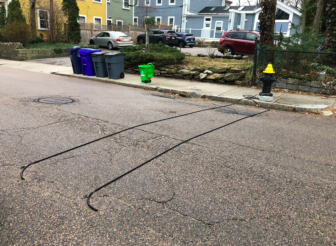Last updated on November 6, 2014

Two intersections two blocks apart in Egleston Square have two distinct problems. This was brought to the attention of Acting Boston Transportation Commissioner Jim Gillooly Tuesday afternoon.
At a joint meeting of the Egleston Square Neighborhood Association and Egleston Square Main Street, the area was painted as a business district crossroads where traffic signals, vehicular turns, school children crossing to the library, pedestrians walking home and traffic back ups all come together.
School Street
School Street, a residential cross-town street with three schools on it, has motorists rushing to catch the Washington Street light. That can endanger children and families who live on the street.
“We have some key issues to look at,” said Tim Reardon of the Neighborhood Association, who led the tour of residents, city transportation officials, Department of Neighborhood Development staffer Kara Miller and Police Officer Carlos Martinez.
Reardon, a Beethoven Street resident, is chair of the Main Street Economic Development Committee and on the Neighborhood Assoc. Executive Committee. He asked an attentive Gillooly to “help us find ideas and next steps.”
Martinez, the beat cop for Egleston Square, pointed out several problems which supported Reardon’s concerns, especially traffic turning and pedestrian crossing. He said the Washington Street/Columbus Avenue intersection is too wide and the crosswalks too long.
“People wait a long time to cross this intersection,” he said, “and sometimes they don’t wait long enough.”
As if on cue, the group watched a woman try to beat traffic crossing Columbus Avenue only to wait on the traffic island to complete her navigation.
Peter DeSaulniers, who has lived at 3091 Washington St. for over three years, took issue with Transportation Department traffic signal engineer when he said the timing to cross was 31 seconds.
“That’s not long enough if you’re disabled,” DeSaulniers said.
Library Crossing Tough on Kids
Neighborhood Assoc. public safety committee member Oren Elow was adamant about one thing, saying it isn’t safe for children to cross to the library or from their homes at Urban Edge housing.

Reardon asked Gillooly for a community process in which both short-term and long-term solutions can be found. Addressing Elow’s concern, Martinez asked if a crosswalk and pedestrian light could be installed at the library as a short-term solution. Giloolly said he would look into that. In response to Reardon’s request for longer-term solutions, such as reducing the width of the Washington-Columbus intersection, the Commissioner said that would take state aid and be part of his five-year budget plan.
At School Street, the problem was traffic speed and conflicts with the Mendell School. There was discussion about traffic calming solutions although Gillooly said he cannot lower the speed limit. Pedestrian safety, especially for school children, was of more concern than traffic flow for School Street. Improved crosswalks at the Mendell was one idea. Residents wanted the city to make School Street a paradigm for traffic calming. At Egleston Square itself the problem was finding the balance between traffic flow and pedestrian crossing.
Speaking to this writer, Reardon said that Neighborhood Association and Main Street coming together makes the point that transportation is not just traffic. It’s an issue for economic development. He also added it’s also part of the effort take down the barrier between Jamaica Plain and Roxbury that four lanes of highway and a median strip has in part created.







